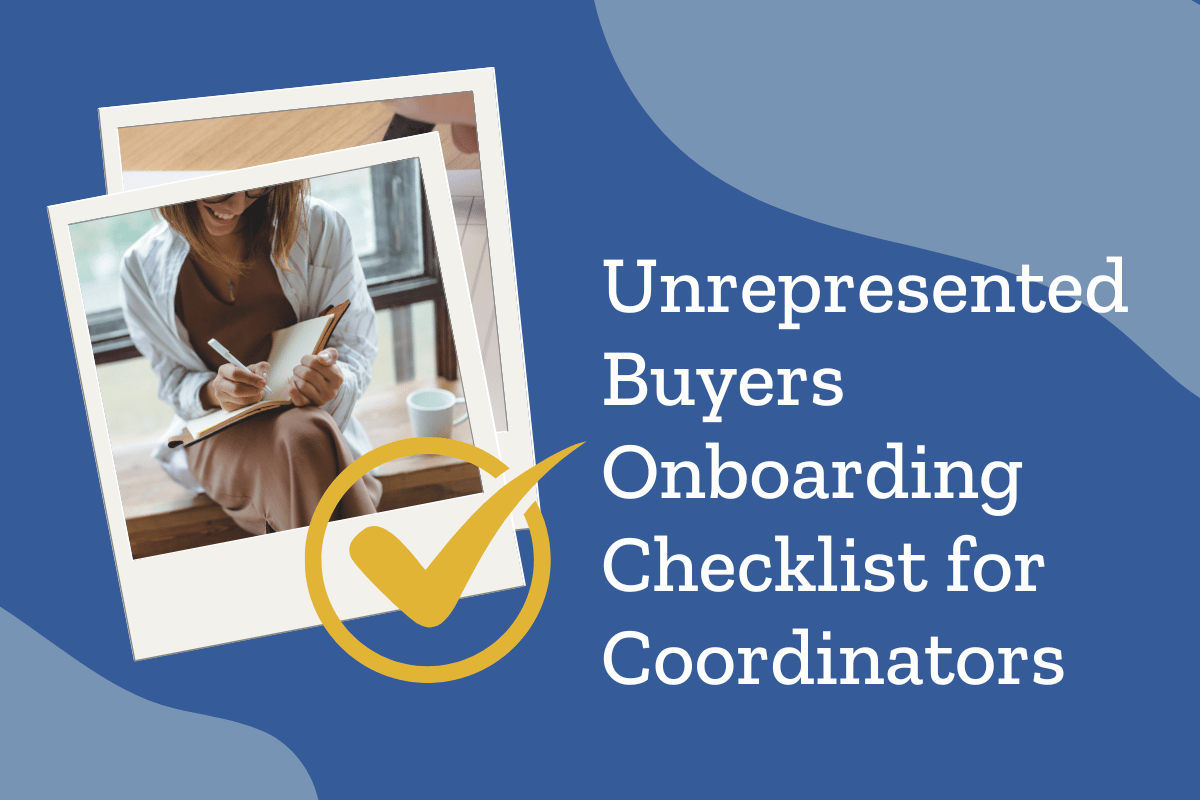Unrepresented buyers aren’t new to the real estate industry.
They’ve been around for years, but their numbers are growing due to market shifts and buyers looking to save on costs.
For transaction coordinators (TCs), this means new challenges and opportunities.
In this article, we’ll go through a full onboarding checklist for unrepresented buyers, tips for adapting it to different types of transactions and how tools can help you with the process.
Impact of Unrepresented Buyers Growth on TCs and Real Estate Professionals
Handling unrepresented buyers requires transaction coordinators to take on a more hands-on role. Without an agent guiding the buyer, you’ll need to be the one ensuring every detail is explained clearly, from start to finish.
For instance, an unrepresented buyer won’t understand the importance of property inspections. You can explain to them why inspections are and coordinate with the listing agent.
What this means for TCs in real estate business:
- More Responsibility: Without real estate agents involved, TCs need to educate buyers on the transaction process, from explaining critical documents to coordinating inspections and deadlines.
- Increase in Communication: Since unrepresented buyers may not have real estate experience, clear communication is essential. Make sure to explain each step of the transaction and provide regular updates. You’ll also need to work on your interpersonal skills and project management.
What this means to other real estate professionals:
Although this article is for transaction coordinators, it’s worth noting the impact it has on other real estate professionals, agents, and brokers. The rise of unrepresented buyers and the updated settlement rules have forced agents to adapt in the following ways:
- With fewer buyers using agents, those in the business need to show their value. Real estate agents will need to explain the benefits they bring, like negotiating better deals or providing market insights that unrepresented buyers will miss.
- Agents are now required to have signed agreements before showing homes and can’t rely on traditional commission structures. They need to get more organized to comply while still managing their workload.
Be prepared with your process as a TC:
- Automation: Invest in customer relationship management (CRM) or transaction management software to monitor interactions, documents, and deadlines.
- Checklists: Use a full checklist so nothing gets missed.
- Templates: Have email templates to explain the process and next steps.
- Documentation: Make sure all forms and disclosures are filled out and signed.
By following these tips, you’ll be ready to handle the growing trend of unrepresented buyers like a pro.
Unrepresented Buyer Onboarding Checklist
This checklist helps independent transaction coordinators guide unrepresented buyers through the home-buying process. It ensures clear communication, sets expectations and provides step-by-step instructions for a smooth transaction.
First Contact
- Start by establishing a clear line of communication.
- Ask about their needs, timeline, and understanding of the process.
- Confirm they are unrepresented and explain your role.
- Discuss how you will help with documentation, appointments and keeping the transaction on track.
- Make sure they understand the scope of your responsibilities and what they will be managing themselves.
Remember to be friendly and professional at all times. It’s better to expect that you’ll be getting many questions from the buyers.
Explaining the Process
- Define your role in the transaction. Make sure that you clearly set the boundaries between being transaction coordinators and real estate agents.
- Explain the steps of the real estate transaction and what the buyer needs to do.
- Provide a simple timeline so they know the key dates, such as inspections, appraisals, and closings.
- Discuss how you will help with document preparation and deadlines.
- Set expectations on when and how you will update them on progress and any issues that come up.
Setting Expectations
- Discuss communication and provide a more detailed timeline.
- Explain the potential pitfalls, like gaps in information because there is no agent.
- Make sure they know how to reach you and your preferred method of communication.
- Decide the response times and your availability to hop on a call or attend to their questions.
- Explain that you will facilitate the transaction, but they need to stay engaged and responsive.
- Prepare them for delays or roadblocks that may happen, and explain how you will help navigate those.
Collecting Information
- Get the key info upfront so you can avoid any delays later. Secure the buyer’s financing info, property interests, and contact info.
- Make sure you have their pre-approval letter from their lender. Get details about their desired properties, including price range and must-haves.
This will help with faster reporting and decision-making throughout the transaction.
Document Review
- Help the buyer understand the important documents without giving legal advice.
- Explain the purchase agreement, disclosures and any addenda.
- Discuss what each document means and what’s involved. Use examples to show what happens if they miss an acceptance deadline.
- Help the buyer review the terms of the escalation addendum and primary terms in the contract.
- Clarify any questions and make sure they understand what each document means when creating an enforceable contract.
By following these steps, you can guide unrepresented buyers through the process and keep it structured.
Customizing the Checklist for Different Transactions
In the real estate business, every deal is different. Customize your unrepresented buyer onboarding checklist for different transaction types.
Residential vs. Commercial Properties
- Residential: Include home inspections, HOA documents, and zoning restrictions.
- Commercial: Add environmental assessments, zoning permits, and commercial compliance checks.
Cash Offers vs. Contingent Sales
- Cash Offers: Simplify the checklist. Focus on clear communication, proof of funds and simple closing steps.
- Contingent Sales: Add contingency removal deadlines, financing approvals and multiple inspection checklists.
Unique Buyer Situations
- First-Time Buyers: Add educational steps. Include detailed explanations of each step, extra hand-holding and recommendations for training programs.
- Investment Properties: Add additional checks for rental market analysis, potential income estimates and tax implications.
Customize for Complexity
- Simple Deals: For easy transactions, keep the checklist short. Focus on the essentials, and don’t add extra steps.
- Complex Deals: For complicated deals, expand the checklist. Add compliance guidelines, consult with other professionals in the real estate business and detailed document reviews.
Practical Tips
- Use a digital tool to manage your checklist so you can customize it for each transaction. ListedKit has free templates to help with that.
- Update your checklist regularly to stay current with new laws and market changes.
Tables for Quick Reference
| Type of Transaction | Key Checklist Items |
|---|---|
| Residential | Home inspection, HOA docs, local zoning |
| Commercial | Environmental assessments, zoning permits |
| Cash Offers | Proof of funds, simplified closing steps |
| Contingent Sales | Contingency deadlines, financing approval |
| First-Time Buyers | Educational steps, detailed process explanations |
| Investment Properties | Rental market analysis, tax implications |
Consider Training Programs
- Offer a compliance program for new transaction coordinators to stay updated.
- Implement regular training programs to keep your skills sharp and your checklist relevant.
Making these adjustments ensures your checklist remains effective, no matter the transaction.
Using ListedKit Features to Simplify the Process
ListedKit has a wide range of features to help you streamline the onboarding process for unrepresented buyers. Here’s how you can use them:
AI Transaction Management
ListedKit uses AI to scan documents and pull out contact info, financials and due dates in seconds. No more hours of digging through paperwork.
Smart Checklists
Creating and managing tasks is easy with real estate transaction checklists. They adjust automatically when closing dates change. No more updating your spreadsheets.
Email Templates
Use pre-written email templates to communicate. Create the email once, and ListedKit will fill in the blanks when you send it. No more mistakes and hours of time lost.
Document Management
Upload and manage unlimited documents. The system stores everything in one place, so you can find any file in seconds.
One-Stop Dashboard
See all your deals in one place. Manage tasks and transactions so you never miss a deadline.
Automated Reminders
Set up automated reminders to notify you and your clients of important dates and tasks. There’s a lower chance of missing a milestone in the transaction.
ListedKit Real-Life Usage
Imagine an unrepresented buyer submits an offer. You upload the initial contract. The AI pulls out the buyer’s contact info and financials.
Next, you use smart checklists to outline all the transaction tasks. When the closing date changes, the checklist updates and reminders go out. Emails to the buyer are pre-filled with current transaction info, so nothing is missed.
Benefits of ListedKit for Independent Transaction Coordinators
- Save Time: Automating data extraction and email templates gives you more time for the important stuff.
- Reduce Errors: Automated reminders so you never forget a date or task.
- Improve Efficiency: Smart checklists and dashboards keep you organized and focused.
Conclusion
A good onboarding process for unrepresented buyers is vital to a smooth transaction.
As a transaction coordinator, you can adapt a checklist and use ListedKit to be more efficient and manage the growing number of unrepresented buyers. You may also add a CRM to your workflow, and you’ll be more productive and successful in your real estate career.
Get started today and review your process to see where you can apply these. Be ahead of the curve, and you’ll be the best in the business.




